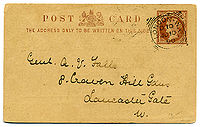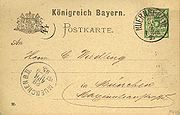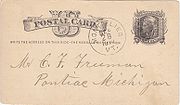
Postal card
Encyclopedia



Postal stationery
A piece of postal stationery is a stationery item, such as a stamped envelope, letter sheet, postal card, lettercard, aerogram or wrapper, with an imprinted stamp or inscription indicating that a specific rate of postage or related service has been prepaid...
with an imprinted stamp
Imprinted stamp
In philately an imprinted stamp is a stamp printed on to a piece of postal stationery such as a stamped envelope, postal card, letter sheet, letter card, aerogram or wrapper. The printing is flat upon the surface of the paper, as opposed to an embossed stamp which has a raised relief...
or indicium signifying the prepayment of postage. They are sold by postal authorities. In January, 1869 Emanuel Herrmann of Austria described the advantages of a Correspondenz Karte. By October, 1869 the world's first postal card was produced by Austria-Hungary. They caught on quickly. By the end of 1870, Great Britain, Finland, Switzerland and Württemberg
Württemberg
Württemberg , formerly known as Wirtemberg or Wurtemberg, is an area and a former state in southwestern Germany, including parts of the regions Swabia and Franconia....
joined the countries issuing postal cards. In the United States, they were first produced in 1873. Some of the forms taken by postal cards include the regular single card which may be commemorative
Commemorative stamp
A commemorative stamp is a postage stamp, often issued on a significant date such as an anniversary, to honor or commemorate a place, event or person. The subject of the commemorative stamp is usually spelled out in print, unlike definitive stamps which normally depict the subject along with the...
or definitive
Definitive stamp
A definitive stamp is a postage stamp, that is part of a regular issue of a country's stamps available for sale by the postal service for an extended period of time...
, attached message-reply cards, airmail
Airmail
Airmail is mail that is transported by aircraft. It typically arrives more quickly than surface mail, and usually costs more to send...
postal cards, and official postal cards used for official government business with a "penalty for private use".
To the post office, there were positive advantages to postal cards as opposed to correspondence in envelope
Envelope
An envelope is a common packaging item, usually made of thin flat material. It is designed to contain a flat object, such as a letter or card....
s. The cards were lighter and less bulky than letters and they were all the same size. The result was that they occupied less than one third of the space required by the same number of letters. To the public there were also advantages. They were simple and cheap making them an instant success. Britain had a half-penny rate to begin with. The U.S. "penny postcard" rate lasted through 1951.
Presumably for the purpose of getting a prompt reply, a sender was given the opportunity to pay for postage both ways with an attached message-reply card, first introduced by Germany in 1873. Other European countries quickly followed suit. Spain furnished message-reply cards to her Colonies: Cuba (1880), Philippines (1889) and Puerto Rico (1898). The U.S. issued them first in 1892. Message-reply cards were attached tête-bêche
Tête-bêche
In philately, tête-bêche is a joined pair of stamps in which one is upside-down in relation to the other, produced intentionally or accidentally. Like any pair of stamps, a pair of tête-bêches can be a vertical or a horizontal pair. In the case of a pair of triangular stamps, they cannot help but...
and likely to be perforated or rouletted to facilitate separation once in the hands of the recipient. The recipient could then tear them apart and use the prepaid reply card to correspond with the original sender. Normally the message card would be identical to the reply card except with the distinction of having additional language such as "WITH REPLY CARD" or "La otra tarjeta es para la respuesta" or "Carte Postale Résponse" or similar words to distinguish the two. In the U.S., message and reply cards have been identical since 1968.
The term postal card is clearly differentiated from the term postcard
Postcard
A postcard or post card is a rectangular piece of thick paper or thin cardboard intended for writing and mailing without an envelope....
which is a term to designate cards prepared by private companies and which do not have prepaid franking. They are readily available at commercial outlets. The addition of an adhesive stamp is required to mail them. They are frequently illustrated with pictures or printed advertisements. They are not considered postal stationery any more than a plain envelope or sheet of parcel wrapping are.
External links
- Postal Cards and Post Cards History: Mostly picture postcards, but some information and illustrations of postal cards.
- Postal Cards of Cuba (1878 -1958): Comprehensive Cuban collection
Further reading
- Higgins & Gage World Postal Stationery Catalog, 19 volumes covering the whole world. Out of print, but worth looking for.
- Stendel, Robert; U.S. Domestic Postal Card Regulations, 1874–1885, United Postal Stationery Society, 2010 edition.
- Falberg, Bill, and Undersander, Dan; Historical Catalog of U.S. Postal Card Essays and Proofs: 1874 - 1885, UPSS, 2008. (electronic version, 2010) 384 pages.
- Krieger, George T.; The Postal Stationery of the Possessions and Administrative Areas of the United States of America; United Postal Stationery Society, 2009, ISBN 978-0-9800112-3-4.
- Littrell, Robert, Ed.; Postal Cards of Spanish Colonial Cuba, Philippines and Puerto Rico, UPSS, 2010.
- Wukasch, Ken; Postal Cards of the World's Columbian Exposition; UPSS, 2005.

